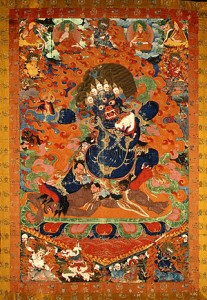Lughnasa Labor Day Moon
Been trying to feel the mountain. Beneath our house Shadow Mountain extends at least 8,800 feet to sea level and just where a mountain begins and ends after sea level is a mystery to me. That’s a mile and 2/3rds of rock. A lot of rock.
14 years ago I came out to Colorado and camped above Georgetown in the National Forest. Right next to me was a sugarloaf mountain. As darkness fell, the mountain disappeared into the gloom. All that massiveness just disappeared. But I could feel it looming over me. Since then I’ve wondered what the mountain equivalent is to the Shedd Aquarium’s freshwater exhibition tag: The essence of a stream is to flow. What is the essence of a mountain?
Mass seems to be the answer. It is the distinctive feature that draws our eyes when we come in on Interstate 76 from the plains of Nebraska. Suddenly, the plains stop. The essence of the plains is flatness? No more flatness, verticality created by mass intervenes with sight lines. The volume of rock pressed upwards by colliding tectonic plates changes the topography.
So these last couple of mornings, before I got out of bed, I’ve been trying to feel the mass of Shadow Mountain. Trying to extend my Self into the mountain, to feel the mountain as it lies there. Not so successful so far. It occurred to me this morning that this is the opposite of conquering the mountain, of summiting, of climbing. This is diving, deepening, merging. Part of the difficulty is the claustrophobic feeling of having the mountain all round me even in my imagination.
This is not all. I noticed the other day in the east, just above the lodgepoles on our property, Orion. In Minnesota I was a late riser so I don’t know where Orion was at 5 am in August, but his presence here surprised me. I have, until now, counted Orion as a winter companion, first becoming visible in November. He may have risen much earlier even in Minnesota, but I missed him. Orion is a special friend, a constellation with which I’ve had a long relationship and one I view as a companion in the night.
Then, there are the bucks. Mule deer bucks. On Sunday as we drove to Evergreen there were four mule deer bucks with still velveted antlers quietly munching grass along the side of the road. They looked at us; we looked at them. The velvet has a prospective nature, auguring the rut when not yet released. On this morning they were friends, not competitors for breeding rights. And they were in harmony.
Then, yesterday, Kate said, “Look at that!” I turned and over my left shoulder looked down into the grassy valley that extends between Shadow Mountain and Conifer Mountain. In the field of mown alfalfa stood a huge bull elk. His rack was enormous and already cleared of its velvet. It arced out away from his head on both sides, tines extending its reach even further. This was a bull of legend. Seeing him took us into the wild, the world that goes on alongside us here on Shadow Mountain, the lives of our fellow inhabitants of this mountain.
All of this, the essence of the mountain, Orion rising, velveted mule deer, the bull elk, hiking on the Upper Maxwell Falls trail, all of this accelerates becoming native to this place. The Rockies. Our home.

